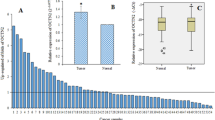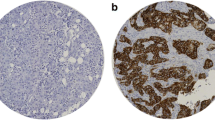Abstract
Background
Breast cancer (BC) is a common malignancy with a high mortality rate. Malignant cell transformation is associated with metabolic changes. One group of proteins that are affected is the monocarboxylate transporters (MCTs-SLC16A). The MCTs comprise 14 members, and they play an important role in the growth, proliferation, and metabolism of cancer cells by transporting monocarboxylates such as lactate, pyruvate and thyroid hormones.
Objective
We aimed to evaluate the expression of MCT3 (SLC16A8), MCT8 (SLC16A2) and MCT9 (SLC16A9) genes in breast cancer samples, comparing to normal adjacent tissues.
Methods
Forty paired breast cancer tumor samples, the adjacent non-tumor and five healthy tissues were collected. Three cancer cell lines (MCF-7, MDA-MB-231, and SKBR3) were also analyzed. The expression of SLC16A8, SLC16A2 and SLC16A9 were assessed using quantitative real-time PCR. The relationship between gene expression with the pathological features of the tumors, and the hormone receptors status of the patient’s tumors were also analyzed.
Results
There was a significantly lower expression of the MCT3 gene in tumor samples compared to adjacent normal tissue and healthy samples (p value < 0.05). There was a significant difference in the expression of all three candidate genes between the BC tissues and normal tissues, and for the, tissues with different hormone receptor status and the molecular subtypes. Altered MCT8 and MCT9 gene expression was associated with a reduced survival
Conclusion
MCT3 expression is significantly downregulated in breast cancer tissue. MCT3 may represent a novel therapeutic target in breast cancer patients, or in some hormone receptor subgroups.











Similar content being viewed by others
Availability of data and material
The data that support the findings of this study are available.
Abbreviations
- BC:
-
Breast cancer
- ER:
-
Estrogen receptor
- HER2:
-
Human epidermal growth factor receptor 2
- MCTs:
-
Monocarboxylate transporters
- LDHs:
-
Lactate dehydrogenases
- AHD:
-
Allan–Herndon–Dudley syndrome
- HPRT1:
-
Hypoxanthine phosphoribosyltransferase1
References
Aveseh M, Nikooie R, Aminaie M (2015) Exercise-induced changes in tumour LDH-B and MCT1 expression are modulated by oestrogen-related receptor alpha in breast cancer-bearing BALB/c mice. J Physiol 593:2635–2648
Badziong J, Ting S, Synoracki S, Tiedje V, Brix K, Brabant G, Moeller LC, Schmid KW, Fuhrer D, Zwanziger D (2017) Differential regulation of monocarboxylate transporter 8 expression in thyroid cancer and hyperthyroidism. Eur J Endocrinol 177:243–250
Bogenrieder T, Herlyn M (2003) Axis of evil: molecular mechanisms of cancer metastasis. Oncogene 22:6524–6536
Chandrashekar DS, Bashel B, Balasubramanya SAH, Creighton CJ, Ponce-Rodriguez I, Chakravarthi BV, Varambally S (2017) UALCAN: a portal for facilitating tumor subgroup gene expression and survival analyses. Neoplasia 19:649–658
Dai X, Cheng H, Bai Z, Li J (2017) Breast cancer cell line classification and its relevance with breast tumor subtyping. J Cancer 8:3131
Do Hyoung L, Kim WS, Kim SJ, Yoo HY, Ko YH (2015) Microarray gene-expression profiling analysis comparing PCNSL and non-CNS diffuse large B-cell lymphoma. Anticancer Res 35:3333–3340
Draoui N, Feron O (2011) Lactate shuttles at a glance: from physiological paradigms to anti-cancer treatments. DMM 4:727–732
Eilertsen M, Andersen S, Al-Saad S, Kiselev Y, Donnem T, Stenvold H, Pettersen I, Al-Shibli K, Richardsen E, Busund L-T (2014) Monocarboxylate transporters 1–4 in NSCLC: MCT1 is an independent prognostic marker for survival. PLoS ONE 9:e105038
Estiar MA, Esmaeili R, Zare A-A, Farahmand L, Fazilaty H, Zekri A, Jafarbeik-Iravani N, Majidzadeh-a K (2017) High expression of CEACAM19, a new member of carcinoembryonic antigen gene family, in patients with breast cancer. Clin Exp Med 17:547–553
Friesema EC, Ganguly S, Abdalla A, Fox JEM, Halestrap AP, Visser TJ (2003) Identification of monocarboxylate transporter 8 as a specific thyroid hormone transporter. J Biol Chem 278:40128–40135
Gallagher SM, Castorino JJ, Wang D, Philp NJ (2007) Monocarboxylate transporter 4 regulates maturation and trafficking of CD147 to the plasma membrane in the metastatic breast cancer cell line MDA-MB-231. Cancer Res 67:4182–4189
Györffy B, Lanczky A, Eklund AC, Denkert C, Budczies J, Li Q, Szallasi Z (2010) An online survival analysis tool to rapidly assess the effect of 22,277 genes on breast cancer prognosis using microarray data of 1,809 patients. Breast Cancer Res Treat 123:725–731
Halestrap AP (2013) The SLC16 gene family–structure, role and regulation in health and disease. Mol Aspects Med 34:337–349
Halestrap AP, Meredith D (2004) The SLC16 gene family—from monocarboxylate transporters (MCTs) to aromatic amino acid transporters and beyond. Pflugers Arch 447:619–628
Halestrap AP, Price NT (1999) The proton-linked monocarboxylate transporter (MCT) family: structure, function and regulation. Biochem J 343:281
Harding C, Pompei F, Burmistrov D, Welch HG, Abebe R, Wilson R (2015) Breast cancer screening, incidence, and mortality across US counties. JAMA Intern Med 175:1483–1489
Hiscox S, Baruah B, Smith C, Bellerby R, Goddard L, Jordan N, Poghosyan Z, Nicholson RI, Barrett-Lee P, Gee J (2012) Overexpression of CD44 accompanies acquired tamoxifen resistance in MCF7 cells and augments their sensitivity to the stromal factors, heregulin and hyaluronan. BMC Cancer 12:458
Hussien R, Brooks GA (2010) Mitochondrial and plasma membrane lactate transporter and lactate dehydrogenase isoform expression in breast cancer cell lines. Physiol Gen 43:255–264
Jézéquel P, Campone M, Gouraud W, Guérin-Charbonnel C, Leux C, Ricolleau G, Campion L (2012) bc-GenExMiner: an easy-to-use online platform for gene prognostic analyses in breast cancer. Breast Cancer Res Treat 131:765–775
Jézéquel P, Frénel J-S, Campion L, Guérin-Charbonnel C, Gouraud W, Ricolleau G, Campone M (2013) bc-GenExMiner 3.0: new mining module computes breast cancer gene expression correlation analyses. Database 2013
Kim GR, Ku YJ, Cho SG, Kim SJ, Min BS (2017) Associations between gene expression profiles of invasive breast cancer and Breast Imaging Reporting and Data System MRI lexicon. Ann Surg Treat Res 93:18–26
Lacroix M, Haibe-Kains B, Hennuy B, Laes J-F, Lallemand F, Gonze I, Cardoso F, Piccart M, Leclercq G, Sotiriou C (2004) Gene regulation by phorbol 12-myristate 13-acetate in MCF-7 and MDA-MB-231, two breast cancer cell lines exhibiting highly different phenotypes. Oncol Rep 12:701–707
Liu Z, Zhang X-S, Zhang S (2014) Breast tumor subgroups reveal diverse clinical prognostic power. Sci Rep 4:4002
Luz M, Perez M, Azzalis L, Sousa L, Adami F, Fonseca F, Alves B (2017) Evaluation of MCT1, MCT4 and CD147 genes in peripheral blood cells of breast cancer patients and their potential use as diagnostic and prognostic markers. Int J Mol Sci 18:170
Mishra D, Banerjee D (2019) Lactate dehydrogenases as metabolic links between tumor and stroma in the tumor microenvironment. Cancers 11:750
Moslemi M, Sohrabi E, Azadi N, Zekri A, Afkhami H, Khaledi M, Razmara E (2020) Expression analysis of EEPD1 and MUS81 genes in breast Cancer. Bio J Sci Tech Res 29:22556–22564
Moslemi M, Moradi Y, Dehghanbanadaki H, Afkhami H, Khaledi M, Sedighimehr N, Fathi J, Sohrabi E (2021) The association between ATM variants and risk of breast cancer: a systematic review and meta-analysis. BMC Cancer 21:1–12
Pérez-Escuredo J, Van Hee VF, Sboarina M, Falces J, Payen VL, Pellerin L, Sonveaux P (2016) Monocarboxylate transporters in the brain and in cancer. Biochim Biophys Acta BBA Mol Cell Res 1863:2481–2497
Pfaffl MW, Horgan GW, Dempfle L (2002) Relative expression software tool (REST©) for group-wise comparison and statistical analysis of relative expression results in real-time PCR. Nucleic Acids Res 30:e36–e36
Pinheiro C, Longatto-Filho A, Scapulatempo C, Ferreira L, Martins S, Pellerin L, Rodrigues M, Alves VA, Schmitt F, Baltazar F (2008) Increased expression of monocarboxylate transporters 1, 2, and 4 in colorectal carcinomas. Virchows Arch 452:139–146
Pinheiro C, Albergaria A, Paredes J, Sousa B, Dufloth R, Vieira D, Schmitt F, Baltazar F (2010) Monocarboxylate transporter 1 is up-regulated in basal-like breast carcinoma. Histopathology 56:860–867
Pinheiro C, Longatto-Filho A, Azevedo-Silva J, Casal M, Schmitt FC, Baltazar F (2012) Role of monocarboxylate transporters in human cancers: state of the art. J Bioenerg Biomembr 44:127–139
Rezaie E, Pour AB, Amani J, Hosseini HM (2019) Bioinformatics predictions, expression, purification and structural analysis of the PE38KDEL-scfv immunotoxin against EPHA2 receptor. Int J Pept Res Ther 26(2):979–996
Rezaie E, Amani J, Pour AB, Hosseini HM (2020) A new scfv-based recombinant immunotoxin against EPHA2-overexpressing breast cancer cells; high in vitro anti-cancer potenc. Eur J Pharmacol 870:172912
Schwartz CE, Stevenson RE (2007) The MCT8 thyroid hormone transporter and Allan–Herndon–Dudley syndrome. Best Pract Res Clin Endocrinol 21:307–321
Si W, Li Y, Han Y, Zhang F, Wang Y, Li Y, Linghu RX, Zhang X, Yang J (2015) Epidemiological and clinicopathological trends of breast cancer in Chinese patients during 1993 to 2013: a retrospective study. Medicine 94(26):e820
Sonveaux P, Végran F, Schroeder T, Wergin MC, Verrax J, Rabbani ZN, De Saedeleer CJ, Kennedy KM, Diepart C, Jordan BF (2008) Targeting lactate-fueled respiration selectively kills hypoxic tumor cells in mice. J Clin Investig 118:3930–3942
Stein C, Colditz G (2004) Modifiable risk factors for cancer. Br J Cancer 90:299–303
Van Der Deure WM, Peeters RP, Visser TJ (2010) Molecular aspects of thyroid hormone transporters, including MCT8, MCT10, and OATPs, and the effects of genetic variation in these transporters. J Mol Endocrinol 44:1
Végran F, Boidot R, Michiels C, Sonveaux P, Feron O (2011) Lactate influx through the endothelial cell monocarboxylate transporter MCT1 supports an NF-κB/IL-8 pathway that drives tumor angiogenesis. Cancer Res 71:2550–2560
Weigelt B, Peterse JL, Van’t Veer LJ (2005) Breast cancer metastasis: markers and models. Nat Rev Cancer 5:591–602
Wolman I (2014) Berek and Novak’s gynecology, 15th edn. Springer, New York
Wong DJ, Hurvitz SA (2014) Recent advances in the development of anti-HER2 antibodies and antibody-drug conjugates. Ann Transl Med 2(12):122
Yersal O, Barutca S (2014) Biological subtypes of breast cancer: prognostic and therapeutic implications. World J Clin Oncol 5:412
Zheng A, Kallio A, Harkonen P (2007) Tamoxifen-induced rapid death of MCF-7 breast cancer cells is mediated via extracellularly signal-regulated kinase signaling and can be abrogated by estrogen. Endocrinology 148:2764–2777
Zhu S, Goldschmidt-Clermont PJ, Dong C (2005) Inactivation of monocarboxylate transporter MCT3 by DNA methylation in atherosclerosis. Circulation 112:1353–1361
Acknowledgements
This study is financially supported by Iran University of Medical Sciences, Tehran, Iran, in 2018. All parts of the work were carried out in the ‘Genetic laboratory of Ali Asghar Children’s’ and Rasoul Akram Hospitals, Tehran, Iran. The authors of the current study would like to express their deep thanks to all staff of these hospitals.
Funding
This study is financially supported by Iran University of Medical Sciences, Tehran, Iran.
Author information
Authors and Affiliations
Contributions
ES, NN, AZ, MK and JF are major contributors in writing the manuscript and design, MM, EH, MK, HA participated in writing the manuscript, MK, JF, HA and MM participated in writing the manuscript and data interpretation, NN, ES and A.Z participated in design, participated in manuscript writing, and conducted statistics. All authors read and approved the final manuscript.
Corresponding authors
Ethics declarations
Conflict of interest
Ehsan Sohrabi, Masoumeh Moslemi, Ehsan Rezaie, Nahid Nafissi, Mansoor Khaledi, Hamed Afkhami, Javad Fathi and Ali Zekri declare that they have no conflict of interest.
Ethics approval and consent to participate
The study was approved by the Ethics Committee of Iran University of Medical Sciences, Tehran, Iran with code number IR.IUMS.FMD.REC.1397.159.
Consent for publication
Not applicable.
Additional information
Publisher's Note
Springer Nature remains neutral with regard to jurisdictional claims in published maps and institutional affiliations.
Rights and permissions
About this article
Cite this article
Sohrabi, E., Moslemi, M., Rezaie, E. et al. The tissue expression of MCT3, MCT8, and MCT9 genes in women with breast cancer. Genes Genom 43, 1065–1077 (2021). https://doi.org/10.1007/s13258-021-01116-w
Received:
Accepted:
Published:
Issue Date:
DOI: https://doi.org/10.1007/s13258-021-01116-w




